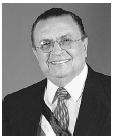COSTA RICA
Abel Pacheco de la Espreilla
President

(pronounced "AY-bell pah-CHAY-koh duh lah ess-PREE-yah")
"We will compete without destroying nature because, beyond the events of the moment, our rich biodiversity will always be a great wealth and we will preserve it."
The Republic of Costa Rica is bounded on the north by Nicaragua and on the southeast by Panama, with coastlines on the Pacific Ocean and the Caribbean Sea. The total area is 50,560 sq km (19,560 sq mi). One-fifth of the land lies less than 122 m (400 ft) above sea level. The rest is highlands and volcanic chains.
The population was estimated at 3.8 million in 2002, growing at a rate of 1.61% annually. The population is 94% white and mestizo (mixed Spanish and Amerindian descent), with the remaining 6% being black, Amerindian, and Chinese. While Spanish is the official language, English is also spoken in some areas. About 76% of the population is Roman Catholic, the remainder being predominantly Protestant. There are small but active Jewish and Buddhist communities as well. The infant mortality rate was estimated at 10.87 deaths per 1,000 live births in 2002; that year life expectancy was 76 years. A high literacy rate (over 95%) and good access to basic health care and education make Costa Rica the most developed country in Central America.
The per capita gross domestic product (GDP) was estimated at US $8,500 in 2001. Average annual growth was fluctuating between 3–5% in 1998–2000, but had slowed to just 0.3% in 2001. Unemployment rose to just over 6% in 2001, with much underemployment also reported. While the country exported about US $5 billion in 2001, it imported more than US $6.5 billion that same year. The unit of currency is the colón , named for Christopher Columbus.
The late 1990s were difficult for the Costa Rican economy. The international price of coffee and bananas, the country's main exports, remained low. The exploitation of rainforests was slowed to protect the environment, causing unemployment in the export sector and a trade balance deficit.
By the early years of the twenty-first century, tourism was expanding, with ecotourism becoming one of the fastest growing industries. Another segment of the economy that was on the rise was the maquilas, or finishing plants, attracted to the region by low labor costs. Critics view the expansion of the unregulated maquilas negatively, referring to these assembly plants as "sweat shops." However, Costa Rica has more environmental protection laws and labor regulations than any other Central American or Caribbean countries. In addition, high literacy levels and a productive workforce has enabled Costa Rica to attract industries employing more highly skilled (and more highly paid) workers than its neighbors. The economy, after an upturn in 1999 in part due to the austerity measures implemented in then-president Miguel Angel Rodríguez's first year in office, had begun to stall by 2000, and was sputtering by the time of the 2002 presidential elections. The government withdrew subsidies for banana and coffee farmers, and the state-run telecommunications business was bogged down, with over 100,000 people waiting for mobile phone service. However, when Rodriguez floated the idea of allowing private enterprise to compete with the state telecommunications agency, protesters flooded the streets.
ADDRESS
President
Casa Presidencial
San José 1000
Costa Rica
Web site:
http://www.casapres.go.cr
Comment about this article, ask questions, or add new information about this topic: